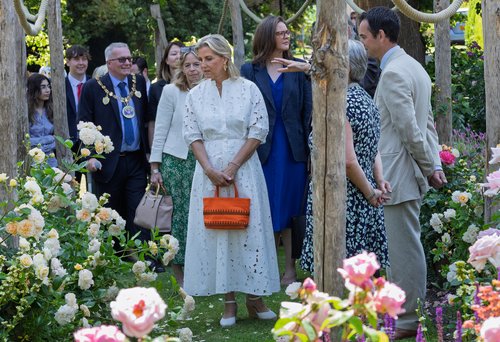
4 minute read
Memories of an ex-Launton Boy
This month the ex-Launton boy recounts some recent work in Rochester Cathedral restoring the Summerhouse in the Cathedral Gardens with a team of Royal Engineers volunteers. This takes his mind back to some of the work he did as a young apprentice in Launton, on the lychgate roof at St Mary’s and on the cricket pavilion at Tusmore Park. Then he tells of the unexpected opening of the restored Summerhouse.
I have been involved with the running of a team of veteran Sappers of the Medway Branch of the Royal Engineers Association in the refurbishment of the Rochester Cathedral Summerhouse in the Cathedral Gardens.
The structure was first built in 1979 by a team from the Corps of Royal Engineers which is very closely associated with Rochester Cathedral. The Corps, albeit under a somewhat different guise, maintains its origins go back to Bishop Gundulf, Chief Engineer to William the Conqueror, who was responsible for the design and construction of Rochester Castle which stands immediately next door to Rochester Cathedral.
There are a great many commemorative plaques inside the Cathedral dedicated to the Corps of Royal Engineers, especially on the inside of the West Wall which houses the main entrance to the Cathedral.
The Summerhouse was first constructed to mark the strong connection between the Corps and the Cathedral, and having fallen into a state of disrepair, the Cathedral officials wanted veterans of the Corps to restore and refurbish it.
I ran a team of just over half a dozen of us, of which four of us were taught the rudiments of designing and making stained glass windows, five in total, which were installed in the Summerhouse, separated by plain glass panels and the roof covered with cedar shingles.
As I reflected on the work we were doing, I was taken back to when I was 15 or 16 years of age as an apprenticed carpenter and joiner with the Launton Building firm of Lewis Penn & Co. Fred Sharpe, of whom I have written on numerous occasions was then the proprietor of the business which by then had moved from constructing new houses to renovating old and well-established buildings, such as farmhouses, vicarages, churches and estate stable blocks. Most of the work as I recall was ecclesiastical, i.e. church-related. And it reminded me of a time when I was involved in some restoration work on the porch over the main gates to St. Mary’s church, Launton, and on another occasion when I made a new notice board for outside the Chapel in Station Road.
I also worked on the building of a new entrance porch to the little church at Oakley at the time the Great Train Robbers were just up the lane at Leatherslade Farm counting out their ill-gotten gains, from where we then went to Haddenham to work on the church roof and then back to St. Edberg’s at Bicester to do likewise.
Back then, we didn’t just have tradesmen, we had Master Tradesmen, people like Bert Massey and Fred Reeves who weren’t just ‘bricklayers’, they were stonemasons and took a great deal of time and pride in their work, so much so, that by today’s standards, you probably couldn’t afford to employ them commercially.
But it was working with them and Jack Spence, the brilliant carpenter and joiner to whom I was apprenticed, that I found myself working on the roof of the cricket pavilion at Tusmore Park, where we re-roofed it using cedar shingles that prompted me to suggest to the Cathedral Principals that maybe we should re-clad the roof of the Summerhouse with cedar shingles for their durability and appearance, to which they agreed.
For those ecclesiastical refurbishments I was involved with when a young apprentice, I was paid a meagre apprentices’ wage. However, the reward for working on and restoring the Summerhouse was quite different and quite unexpected.
I was asked to assemble the team, or as many as were available, to gather at the site of the Summerhouse on the morning of Friday 13 June for a special Open Day, preferably dressed in our blazers, flannels and Corps tie, which we dutifully did.
Half an hour later we heard a helicopter coming in to land somewhere nearby, Half an hour later again, I was introduced to Sophie, the Duchess of Edinburgh. She is such a lovely lady and so easy and relaxed to speak with. I introduced her to the members of my team and then escorted her to the inside of the Summerhouse, with which she was most taken, especially the stained glass windows. She stayed with us for a good twenty minutes in blistering heat.
What a reward, better than any wage packet. Keep healthy and stay SAFE!
TonyJeacock, MInstRE | The ex-Launton Boy | July 2025










